Wonderful 1-Fabric Quilt for Rene
March 2009
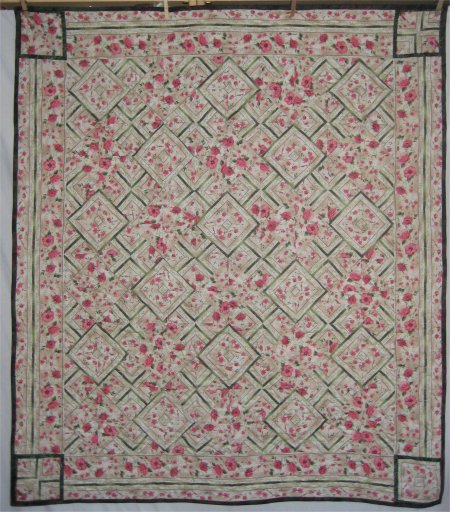
size: 43" x 50"

With so many quilting books being published, it's not surprising that, unless you constantly and consistently peruse the quilt store racks or are given a heads-up by a buddy, the average person misses most of them. And so it was with "Wonderful 1-Fabric Quilts" by Kay Nickols (ISBN 978-1-57432-936-0), published in 2007.
I completely missed this book when it first came out. It wasn't until at local quilt show in 2009 when I saw a quilt made from this book that I became aware of it. The cover of the book, although accurately showing the effects of the technique, doesn't do the quilt near the justice that it should. The same quilt on the frontispiece is a MUCH better showing. It is AWESOME.
You. Go out and buy this book. Now. Scoot .. come back later and read this page but .. go. Now. Do it. :-)
I was able to find my copy on the used book pages of Amazon.com ... a wonderful source for books, if you don't mind waiting until the book isn't current. :-)
The premise of the technique is rather like a Stack-n-Whack but with squares, rather than triangles. Using a fabric with lengthwise stripes, you cut the stripes in squares, based on the width of the stripe repeat. The squares are then cut twice diagonally and the resultant triangles are recombined into the Wonderful 1-Fabric Quilt. The book shows several different layout versions.
Have you bought the book yet?
I knew I had several lengthwise striped fabrics in my stash. We all probably do, simply because the stripes are just so danged attractive. BUT ... heck, what DO you do with them?? Besides use them for borders, that is. Well, with this book, you can now make an incredible quilt with the stripes that won't end up looking like stripes. It'll look horribly inricate and tedious to sew. Your friends and acquaintances .. heck, even your enemies .. will be astounded at your adroit cleverness. YOU should never enlighten them. Just bask in the gentle afterglow. :-)
Have you bought the book yet?
 The first striped piece I pulled from my stash was a lovely rose and ecru floral. Since it was in the red/pink family, it was destined for Rene, my youngest DD. However, upon close inspection, I discovered that it was NOT a full width of fabric. Obviously some of the lengthwise stripes had been cut off previously but I was at a complete loss as to what I could have done with it. Perhaps I got this fabric at a swap? from a thrift store? I hadn't a clue. Sadly, it wasn't until I was finished with the top that I realized I should have taken a picture of the fabric before I cut it up. This is all that I have left, besides a few short squares. According to the selvage information, this is "Essence of Roses" by Fabri-Quilt.
The first striped piece I pulled from my stash was a lovely rose and ecru floral. Since it was in the red/pink family, it was destined for Rene, my youngest DD. However, upon close inspection, I discovered that it was NOT a full width of fabric. Obviously some of the lengthwise stripes had been cut off previously but I was at a complete loss as to what I could have done with it. Perhaps I got this fabric at a swap? from a thrift store? I hadn't a clue. Sadly, it wasn't until I was finished with the top that I realized I should have taken a picture of the fabric before I cut it up. This is all that I have left, besides a few short squares. According to the selvage information, this is "Essence of Roses" by Fabri-Quilt.
However, even without it being full width, I still had enough to play with ... and eventually made a throw-sized quilt using the on-point layout for Rene that finished at 43" x 50". You might note the cornerstones ... looks like I really had a creative idea there. :-) Sadly, not. Along with the less-than-full-width striped fabric, there was also 2 pieces of lengthwise stripes cut separately ... almost long enough for a mitered border (which I think would have looked best). However, since they *weren't* long enough and I didn't want a butted border, I decided to put in cornerstones. Unfortunately (why do a lot of my quilts present themselves as Creative Opportunities?), I didn't have any blocks wide enough for the borders but I DID have some smaller blocks. I framed them with a mottled green batik to bring them up to size.
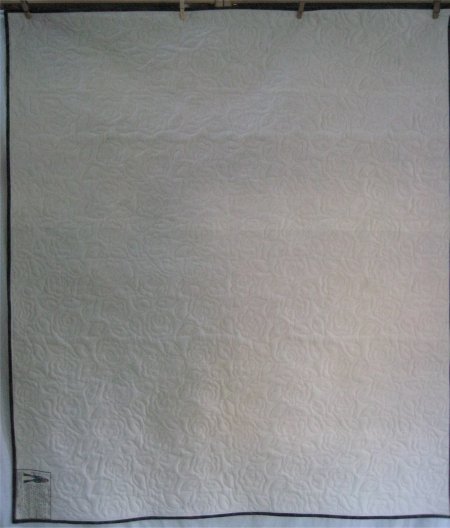
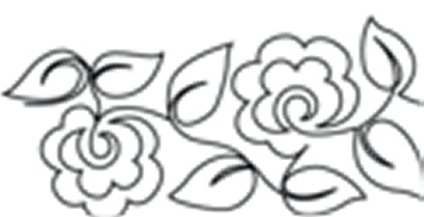 Now it was time to load the quilt onto Lizzie, and quilt. Rene had seen the rose floral pantograph I had used on a charity quilt and liked it. I cautioned her that the design of the quilting would be lost in the "busy-ness" of the top, but she wanted it anyway. The customer always wins. :-) I used plain unbleached muslin for the backing and light pink thread, so the design could be seen on the back. Sure enough, you can't see a danged thing on the front, but as the picture on the left shows, it produces a lovely textured effect from the back. A close-up reveals the actual stitched panto design.
Now it was time to load the quilt onto Lizzie, and quilt. Rene had seen the rose floral pantograph I had used on a charity quilt and liked it. I cautioned her that the design of the quilting would be lost in the "busy-ness" of the top, but she wanted it anyway. The customer always wins. :-) I used plain unbleached muslin for the backing and light pink thread, so the design could be seen on the back. Sure enough, you can't see a danged thing on the front, but as the picture on the left shows, it produces a lovely textured effect from the back. A close-up reveals the actual stitched panto design.
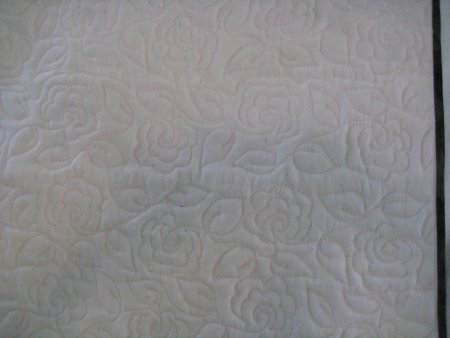
I had wanted to use the same mottled green batik for the binding, but alas, I didn't even have a fat quarter's worth of it left. A trip to my local quilt store, Thimble Creek, produced another mottled dark green and very dark pink batik that worked well as the binding.
Because I am still "practicing" with my Lizzie and still experiencing a learning curve at various times, this quilt gave me a Learning Oppportunity that worked out rather nicely. When you are working with pantographs, when you come to the end of the panto strip (however many passes the panto will allow), you must inevitably roll the quilt in order to quilt the next section. The trick is to align the previously stitched rows with the pantograph paper so that it won't LOOK like .. oh my gosh, this is where the quilt was advanced! Some pantographs have alignment marks to make this easier but you still have the Human Element to work with.
This panto did not have alignment marks, but knowing how they should be, I simply drew my own. Not a big deal. So I stopped quilting with the needle down at the alignment mark in the quilt, rolled the quilt until the laser light hit the alignment mark on the panto and continued quilting. It wasn't until I had completely finished the pass and looked at the wonderful work that I realized .. ooops ... the rows were slightly too far apart and there was a noticeable "puffiness" between them. Drats. It appeared that I'm not quite as clever as I thought I should be.
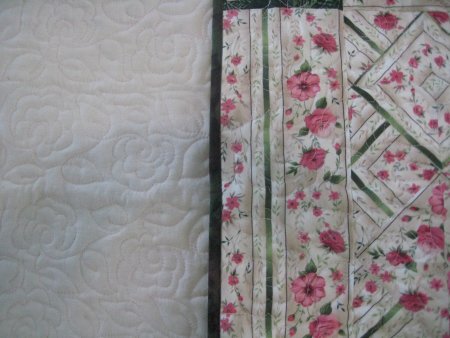 BUT .. a clever, clever solution to this problem is at hand! When I first got Lizzie, I took a long weekend class with Cindy Roth at Longarm University in Washington state. Cindy's classes are incredibly useful for anyone who has a longarm quilting machine; you don't need to have her brand of longarm.
BUT .. a clever, clever solution to this problem is at hand! When I first got Lizzie, I took a long weekend class with Cindy Roth at Longarm University in Washington state. Cindy's classes are incredibly useful for anyone who has a longarm quilting machine; you don't need to have her brand of longarm.
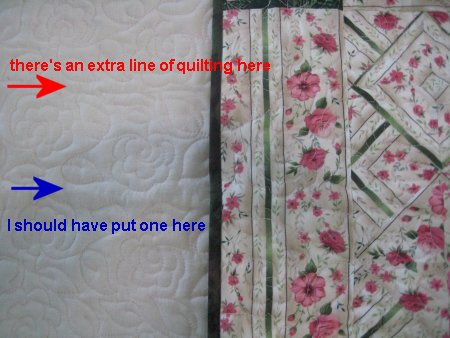 One tip she gave us was exactly how to fix this sort of row problem: you simply free-motion an extra line of stitching between the rows that are too far apart, mimicing the lines of the design. NO ONE will EVER notice that there is an extra line there, even if the quilting thread is high contrast on a solid fabric. Absolutely BRILLIANT. And so I tried it. Can YOU see the extra quilting line on the picture on the right? I knew that even I'd never be able to spot the extra line from the front of this quilt, but I was amazed at how well camoflagued that extra line is on the back! In that link, you'll see where I should have put an extra line between another set of rows, but I didn't see that place until I had completely taken the quilt off of Lizzie and really didn't want to reload it. Yes, I am just that lazy.
One tip she gave us was exactly how to fix this sort of row problem: you simply free-motion an extra line of stitching between the rows that are too far apart, mimicing the lines of the design. NO ONE will EVER notice that there is an extra line there, even if the quilting thread is high contrast on a solid fabric. Absolutely BRILLIANT. And so I tried it. Can YOU see the extra quilting line on the picture on the right? I knew that even I'd never be able to spot the extra line from the front of this quilt, but I was amazed at how well camoflagued that extra line is on the back! In that link, you'll see where I should have put an extra line between another set of rows, but I didn't see that place until I had completely taken the quilt off of Lizzie and really didn't want to reload it. Yes, I am just that lazy.
And I did figure out why the rows were further apart than they should have been ... it's that flakey Human Element again. :-) The laser light holder on my Lizzie is a horizontal piece of wood that is bolted to a wooden block on Lizzie's carriage. The bolt wasn't as tight as it should have been and when Lizzie was at the belly bar, the horizontal piece of wood was nudged out of place by the take-up roller. Oops. Since the laser was then moved slightly forward of where it should have been, even when the laser light was on the alignment mark, it was out of place row-wise. I simply needed to reposition the laser light bar back into its proper position. :-)